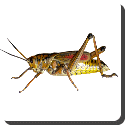 Grasshopper — Grasshoppers are herbivorous insects of the suborder Caelifera in the order Orthoptera. To distinguish them from bush crickets or katydids, they are sometimes referred to as short-horned grasshoppers. Species that change color and behavior at high population densities are called locusts.
Grasshopper — Grasshoppers are herbivorous insects of the suborder Caelifera in the order Orthoptera. To distinguish them from bush crickets or katydids, they are sometimes referred to as short-horned grasshoppers. Species that change color and behavior at high population densities are called locusts.
The Grasshoppers have antennae that are almost always shorter than the body (sometimes filamentous), and short ovipositors. Those species that make easily heard noises usually do so by rubbing the hind femurs against the forewings or abdomen (stridulation), or by snapping the wings in flight. Tympana, if present, are on the sides of the first abdominal segment. The hind femora are typically long and strong, fitted for leaping. Generally they are winged, but hind wings are membranous while front wings (tegmina) are coriaceous and not fit for flight. Females are normally larger than males, with short ovipositors.
They are easily confused with the other sub-order of Orthoptera, Ensifera, but are different in many aspects, such as the number of segments in their antennae and structure of the ovipositor, as well as the location of the tympana and modes of sound production. Ensiferans have antennae with at least 30 segments, and caeliferans have fewer. In evolutionary terms, the split between the Caelifera and the Ensifera is no more recent than the Permo-Triassic boundary.
Digestion and excretion
The digestive system of insects includes a foregut (stomodaeum – the mouth region), a hindgut (proctodaeum – the anal region), and a midgut (mesenteron). The mouth leads to the muscular pharynx, and through the esophagus to the crop. This discharges into the midgut, which leads to the malpighian tubules. These are the chief excretion organs. The hindgut includes intestine parts (including the ileum and rectum), and exits through the anus. Most food is handled in the midgut, but some food residue as well as waste products from the malpighian tubules are managed in the hindgut. These waste products consist mainly of uric acid, urea and a bit of amino acids, and are normally converted into dry pellets before being disposed of.
The salivary glands and midgut secrete digestive enzymes. The midgut secretes protease, lipase, amylase, and invertase, among other enzymes. The particular ones secreted vary within the different diets of grasshoppers.
Grasshoppers as food
In many places around the world, grasshoppers are eaten as a good source of protein. Tsukudani of grasshoppers are eaten in the mountainous part of Japan and commonly sold in souvenir shops.
Raw grasshoppers should be eaten with caution, as they can contain tapeworms.
 Kids Portal For Parents India Kids Network
Kids Portal For Parents India Kids Network
